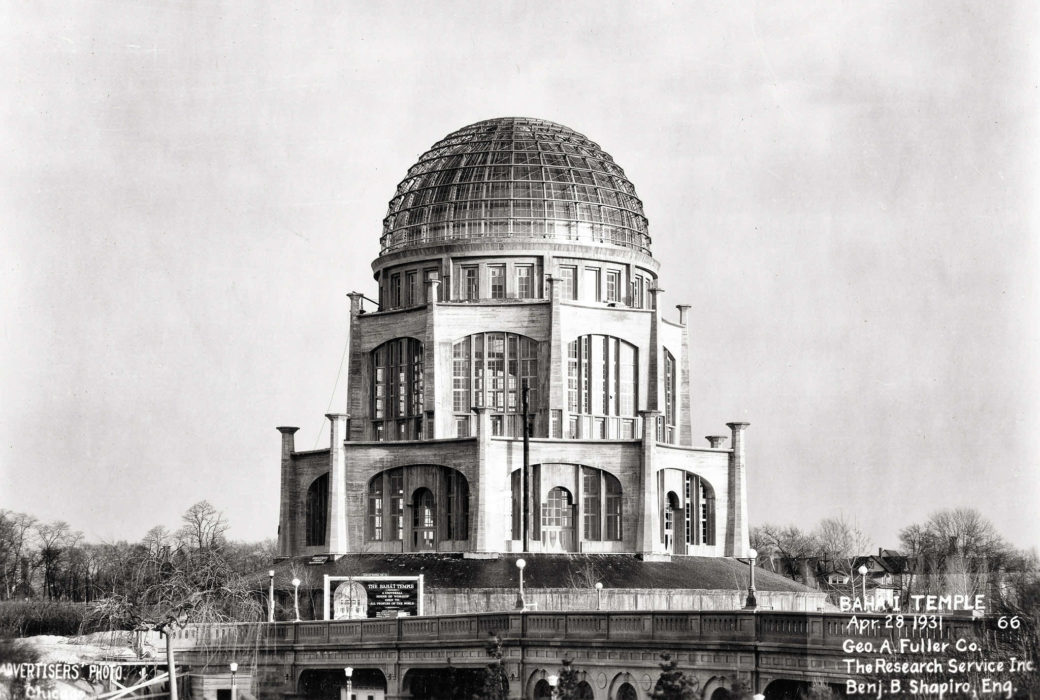THE SUN PEEKED OVER the horizon as ‘Abdu’l-Bahá’s train steamed toward the western outskirts of Chicago for his third, and final, stay in the city. He had first disembarked in the Windy City on April 29, 1912, less than three weeks after he set foot in America. On that trip he laid the cornerstone of the first Bahá’í House of Worship in the West. Over the next four decades, the structure’s shimmering figure, draped in a filigreed gown of white quartz and portland cement, would slowly rise over the construction site at Grosse Point, on the western shore of Lake Michigan just north of Chicago.
‘Abdu’l-Bahá had returned to Chicago on his trip west on September 12, stopping for five days with a side trip to Kenosha, Wisconsin. Stepping onto the platform at LaSalle Street Station, he saw a young Japanese student dangling from a lamp post, struggling to get a glimpse of him. Saichiro Fujita became ‘Abdu’l-Bahá’s guest for the four thousand mile trip to California and back. Now, seven weeks later, Fujita would leave the party and live in Chicago. ‘Abdu’l-Bahá once again took up residence at the Plaza Hotel on Lincoln Park, where, to a packed ballroom six months before, he had argued for America’s immense potential, challenging the young nation to play a leading role on the world stage.
It is hard to believe that the massive city ‘Abdu’l-Bahá visited had only been in existence for seventy-nine years. In 1833 Chicago was incorporated with a population of 350, but now, in 1912, more than 2.3 million residents swelled its streets, making it the world’s sixth largest city. It was also the busiest transportation hub on the planet, and competed only with New York for the distinction of having the world’s tallest building — an honor that changed hands every few years.
Historian Paul Johnson, in his monumental A History of the American People, identifies an early moment in Chicago’s history as emblematic of American determination and ingenuity. In the mid-1850s it became clear that the city’s lack of proper drainage was responsible for growing epidemics of typhoid fever, dysentery, and cholera. It simply sat too low in the water table. The solution? Lift up the hundred or so buildings that comprised downtown: lift them six feet.

Over the next ten years entire city blocks were raised, an incredible feat of engineering involving tens of thousands of jackscrews and hydraulic lifts. And, even as they were being hoisted out of the muck, the buildings stayed open, and Chicago’s daily business continued. This could never have happened in Europe, Johnson notes, because a uniquely American conviction drove the enterprise: “that nothing material is impossible.”
‘Abdu’l-Bahá had praised America’s material ingenuity and advancement from the moment reporters greeted him aboard the SS Cedric in New York Harbor on April 11. But he also believed the nation’s people had a unique spiritual potential, and called on Americans to realize it. During his final visit to Chicago, he raised the point again.
“Chicago has great capacity,” he told those gathered at the Plaza Hotel on November 1. “I hope that the banner of the unity of mankind will be unfurled in this city.” As usual, hundreds of Chicagoans turned up to meet him each day. “This is the third time that I am in Chicago,” he said, and joked with the visitors that it was now their turn to return the favor and visit him in Palestine. ‘Abdu’l-Bahá had a specific challenge for the city’s Bahá’ís. “Strive day and night for the public weal,” he told them. He encouraged them to display a level of unity and sacrifice that would cause “the dormant pulse of this country [to] beat vigorously.”
“You must not look at present accomplishments,” he admonished some listeners at Corinne True’s home at 5338 Kenmore Avenue, “for this is but the beginning.”






